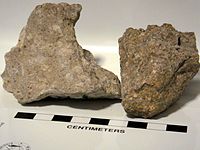Tephra: Difference between revisions
m Reverted edits by 198.62.116.254 (talk): not adhering to manual of style (HG) (3.4.9) |
Mikabella95 (talk | contribs) →Overview: Added a citation. |
||
| Line 13: | Line 13: | ||
[[File:BishopTuff.jpg|thumb|right|200px|Rocks from the [[Bishop tuff]], uncompressed with [[pumice]] on left; compressed with [[fiamme]] on right]] |
[[File:BishopTuff.jpg|thumb|right|200px|Rocks from the [[Bishop tuff]], uncompressed with [[pumice]] on left; compressed with [[fiamme]] on right]] |
||
The distribution of tephra following an eruption usually involves the largest boulders falling to the ground quickest, therefore closest to the vent, while smaller fragments travel further – ash can often travel for thousands of miles, even circumglobal, as it can stay in the [[stratosphere]] for days to weeks following an eruption. |
The distribution of tephra following an eruption usually involves the largest boulders falling to the ground quickest, therefore closest to the vent, while smaller fragments travel further – ash can often travel for thousands of miles, even circumglobal, as it can stay in the [[stratosphere]] for days to weeks following an eruption. |
||
When large amounts of tephra accumulate in the atmosphere from massive volcanic eruptions (or from a multitude of smaller eruptions occurring simultaneously), they can reflect light and heat from the sun back through the atmosphere, in some cases causing the temperature to drop, resulting in a temporary "[[volcanic winter]]". |
When large amounts of tephra accumulate in the atmosphere from massive volcanic eruptions (or from a multitude of smaller eruptions occurring simultaneously), they can reflect light and heat from the sun back through the atmosphere, in some cases causing the temperature to drop, resulting in a temporary "[[volcanic winter]]". The effects of acidic rain and snow, the precipitation caused by tephra discharges into the atmosphere, can be seen for years after the eruptions have stopped. Tephra eruptions can affect ecosystems from miles to kilometers depending on the size of the eruption. <ref>{{Cite journal|last=Ayris|first=Paul Martin|last2=Delmelle|first2=Pierre|date=2012-11-01|title=The immediate environmental effects of tephra emission|url=https://doi.org/10.1007/s00445-012-0654-5|journal=Bulletin of Volcanology|language=en|volume=74|issue=9|pages=1905–1936|doi=10.1007/s00445-012-0654-5|issn=1432-0819}}</ref> |
||
==Classification== |
==Classification== |
||
Revision as of 02:13, 26 February 2020
This article needs additional citations for verification. (October 2017) |

Tephra is fragmental material produced by a volcanic eruption regardless of composition, fragment size, or emplacement mechanism.[1]

Volcanologists also refer to airborne fragments as pyroclasts. Once clasts have fallen to the ground, they remain as tephra unless hot enough to fuse together into pyroclastic rock or tuff.

Overview
This section needs additional citations for verification. (October 2017) |

The distribution of tephra following an eruption usually involves the largest boulders falling to the ground quickest, therefore closest to the vent, while smaller fragments travel further – ash can often travel for thousands of miles, even circumglobal, as it can stay in the stratosphere for days to weeks following an eruption. When large amounts of tephra accumulate in the atmosphere from massive volcanic eruptions (or from a multitude of smaller eruptions occurring simultaneously), they can reflect light and heat from the sun back through the atmosphere, in some cases causing the temperature to drop, resulting in a temporary "volcanic winter". The effects of acidic rain and snow, the precipitation caused by tephra discharges into the atmosphere, can be seen for years after the eruptions have stopped. Tephra eruptions can affect ecosystems from miles to kilometers depending on the size of the eruption. [2]
Classification
Tephra fragments are classified by size:

- Ash – particles smaller than 2 mm (0.08 inches) in diameter
- Lapilli or volcanic cinders – between 2 and 64 mm (0.08 and 2.5 inches) in diameter
- Volcanic bombs or volcanic blocks – larger than 64 mm (2.5 inches) in diameter
The use of tephra layers, which bear their own unique chemistry and character, as temporal marker horizons in archaeological and geological sites, is known as tephrochronology.
Etymology
The word "tephra" and "pyroclast" both derive from Greek: τέφρα tephra means "ash", while the word pyroclast is derived from the Greek πῦρ (pyr), meaning "fire", and κλαστός (klastos), meaning "broken in pieces".
References
- ^ This is the broad definition of tephra (Greek tephra, "ash") proposed by the Icelandic volcanologist Sigurður Þórarinsson (Sigurdur Thorarinsson) in 1954, in connection with the eruption of Hekla (Thorarinsson, "The eruption of Hekla, 1947-48II, 3, The tephra-fall from Hekla, March 29th, 1947", Visindafélag Íslendinga (1954:1-3).
- ^ Ayris, Paul Martin; Delmelle, Pierre (2012-11-01). "The immediate environmental effects of tephra emission". Bulletin of Volcanology. 74 (9): 1905–1936. doi:10.1007/s00445-012-0654-5. ISSN 1432-0819.
External links
 Media related to Tephra at Wikimedia Commons
Media related to Tephra at Wikimedia Commons- How Volcanoes Work
- Volcanic Materials Identification
- Pictures of lunar landscape between Guatiza and Teseguite in Lanzarote
